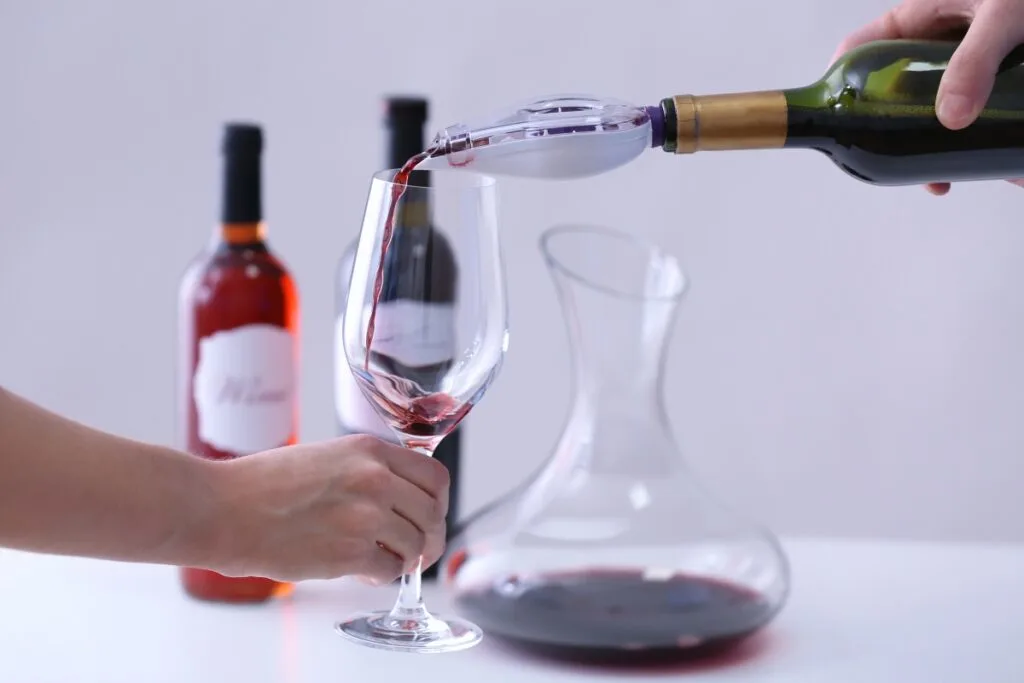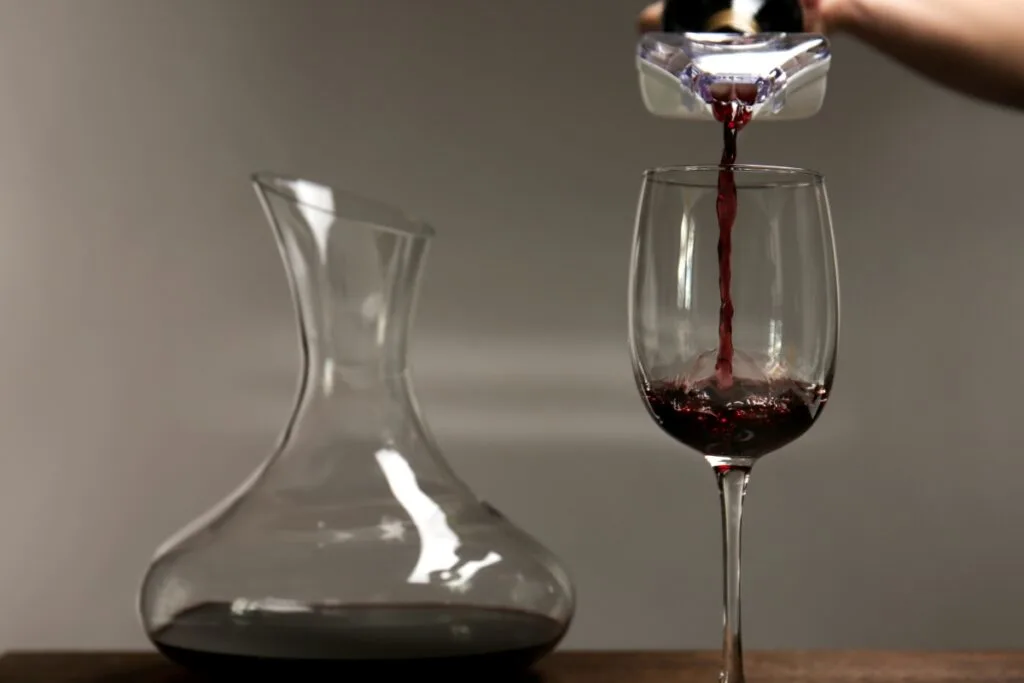As an Amazon Associate, I earn from qualifying purchases with no additional costs for you.
I have often experienced restaurants serving wine in a carafe while wine experts talk about the benefits of using a decanter for wine. So, I set about learning the differences to understand better how to get the maximum enjoyment from my wine.
A decanter is just used for wine and has a wide base to expose more wine to oxygen. A narrower and more elongated carafe can be used for water, juice, and wine. Some carafes are insulated and can hold hot beverages like coffee or tea.
Let’s take a closer look at the differences between a decanter and a carafe so that you can get a clear picture of how to use each of them best and enjoy your wine at the absolute peak of its flavors.

TIP: If you want to check out the best refrigerator for wine storage, I recommend trying out the Avation (18 bottles) compressor refrigerator with Wi-fi smart app control cooling system. You can find this refrigerator by clicking here (Amazon link).
What Is The Difference Between A Decanter And A Carafe
The most significant difference between a decanter and a carafe is the purpose for which the vessel is used. A carafe is an elongated vessel used to serve juice, water, or wine. A decanter, by contrast, has a wide base used to aerate/oxygenate the wine and serve wine, especially on special occasions.
Full-bodied red and vintage wines tend to accumulate sediment in the bottle. By carefully pouring the wine into a decanter, you can filter out the sediments from the wine you serve.
Although using a carafe will work just as well for filtering the sediments, you won’t have the effect of aeration, which is vital for smoothing out the tannins of full-bodied red wines.
In the world of decanters, not all decanters are created equal. The sizes of small, medium, and large when referring to decanters don’t indicate the volume of wine that the decanter can hold but rather the size of the decanter’s base.
The wider the base, the greater the surface area of the wine and the more aeration that can take place. These different sizes of decanters are intended for other wines based on the amount of decanting that wine needs to be served at its best.
In her book Wine Folly, Madeline Puckette shows examples of the different sizes of decanters and the wines that they are best suited for. Her example of a size small decanter that is best for rose and white wine looks essentially identical to most carafes from my perspective.
Recommendation box: Everything you need to enjoy your wine as much as possible. All recommended products are personally tested and regularly used by experts from this website (Amazon links):
> Ivation Wine Cooler – Energy-efficient wine cooler for 18 bottles with Wi-fi smart app control cooling system.
> Wine Rack – Beautiful, elegant wood rack for up to 7 bottles and the choice of vertical or horizontal storage.
> Durand Wine Opener – Classic vintage wine opener (we like all these classic staff).
> YouYah Iceberg Wine Decanter – The most beautiful and handy wine decanter we personally use.
> Bormioli Rocco Wine Glasses – A set of eight elegant and traditional wine glasses made in Italy.
> Vintorio Wine Aerator – Simple but really useful wine aerator for a reasonable price.
> The Original Vacu Vin Wine Saver – The best wine saver on the market in a package with two vacuum stoppers and two wine servers.
And if you want to become a true connoisseur of wine, we recommend reading the book Wine Folly: The Essential Guide to Wine (Amazon link), where you will find all the information you need about winemaking, wine varieties, flavors, and much more.
What Is A Wine Decanter?
A wine decanter is a glass vessel with the primary function of aerating wine, especially red and vintage wine that benefits from oxygenation. You can easily recognize a decanter by its unusually wide base.
Wine in a decanter spreads out across the wide base, giving the wine a greater surface area and, therefore, more exposure to oxygen.
Aside from the traditional shape of the decanter with a wide base and tall neck, decanters are also available in ornate shapes that can make for an artistic feature on a dinner table.
Depending on the size of the dinner table, a large-sized decanter with a very wide base can potentially take up too much space, making the table feel crowded.
In this instance, it might be better to double-decant the wine into something narrower, like a carafe, to serve.
TIP: If you are interested in buying a wine decanter, I recommend purchasing these two top-quality decanters:
- USBOQO Wine Decanter (check it out on Amazon & read customer reviews)
- Iceberg Wine Decanter (check it out on Amazon & read customer reviews)
What Is The Purpose Of A Decanter?
At first glance, a decanter might seem like nothing but an ornate glass vessel serving wine. However, the purpose of a decanter extends far beyond that. It allows for the wine to have increased oxygen exposure.
So while it might not look like much is going on when you decant wine, the increased oxygen exposure softens all the astringent tannins and brings out all the fruity and floral aromas. So, in short, decanting makes wine taste better.
Lighter wines like rose and white wines need less decanting than full-bodied red wines with high tannin levels to bring them to the peak of their flavor.
TIP: Wine Decanting is among wine lovers’ most discussed topics. Read this article to find out which wines need to be decanted. If you don’t have a decanter, this article offers a few tips on what to do. Wine decanters are often made of soft glass, so be careful when you clean them. This article explains how to wash decanters in the dishwasher.
What Is A Carafe?
The easiest way to explain a carafe is to say how it differs from a decanter in style, shape, and purpose.
In contrast to the wide base of a decanter, a carafe will be narrower and more elongated. This difference is more pronounced when comparing a carafe to medium and large-sized red wine decanters.
White wine decanters (also used for rose wine) are substantially narrower than red wine decanters and sometimes get confused for carafes. However, carafes will still, in general, be more elongated than white wine decanters.
What Is The Point Of A Carafe?
A carafe is a vessel for serving beverages at room temperature. So, while a decanter is used explicitly for wine, a carafe can serve water, juice, or wine.
I often use a carafe for serving wine when bits of cork has fallen into the wine bottle or there is some sediment I want to filter out of the wine, but I don’t want to use a decanter.
TIP: Can you drink wine with cork in it? Read this article to find out. This article explains how to save wine from damaged, tainted or crumbled cork.
When I get together with friends for a wine tasting, we often use carafes to hold the different wines and turn them into blind tasting – even when just comparing two wines. That way, we get more enjoyment from the tasting experience and don’t pre-judge cheaper wines.
Do You Drink a Wine From A Carafe?

A carafe is used for holding and serving beverages. The beverage is then poured into the glass from which you drink. Drinking directly from a carafe is frowned upon as the carafe is a shared vessel for holding the shared beverage for several people sitting together at a table.
However, there is one notable exception to the never drinking directly from a decanter rule. Here I am referring to the porron, the traditional decanter used in the Spanish region of Catalunya.
A porron has a long and very narrow spout. The porron is held arm’s-length away, and you catch the stream of wine in your mouth without spilling any.
Drinking wine from a porron in a Spanish restaurant.
TIP: Does a wine decanter need a stopper? Decanters with stoppers are only helpful if you often do not finish your decanted wine. Find out more in this article. Both wine decanters and wine aerators are standard tools to enhance the wine. Check out the difference between decanters and aerators in this article.
Do You Even Need A Decanter?
In order to decant wine, you need a clean glass container with a wide enough base so that the wine can have a large surface area exposed to oxygen.
It does not need to be a purpose-made decanter. I have successfully decanted wine using a mixing bowl and a vase and many times using jugs.
A friend of mine in college even decanted wine using a clean fish bowl, and the result was perfectly adequate. However, I would advise against trying to decant wine with a blender.
I tried that once, and although I was successful in smoothing out the tannins of my cabernet, the chopping action of the blender somehow removed all the aromas as well, leaving me with a red liquid that only tasted of alcohol.
Can You Decant Wine In A Carafe?
As I mentioned earlier, a small-sized decanter looks remarkably similar to a carafe. Therefore, it is entirely possible to decant rose wines and white wines using a carafe.
However, a carafe does not expose much surface area of the wine to oxygen, so it is not ideal for decanting red wines, especially full-bodied red wines. Though still possible, it can take hours to decant a full-bodied red wine in a carafe fully.
What carafes are excellent at is the second part of a double-decanting process. So, I would pour the wine through an aerator like this Vintorio aerator (available on Amazon) when pouring from the bottle into the carafe.
These days I have more confidence in using an aerator combined with a carafe, thanks to the paper published by David F. Brandley at Cornell University.
In his conclusion, an “average” wine drinker could not distinguish between the aerated and control samples. The sommelier Madeline Puckette could detect a difference but stated that the aerator produced incomplete decanting.
Conclusion
In essence, the two differences between a decanter and a carafe are their shape and purpose.
A decanter is designed to be used for wine and is characterized by a wide base that exposes a greater surface area of the wine to oxygen.
By contrast, a carafe is narrower and more elongated. We use carafes for water, juice, as well as wine.
TIP: Check out this page for a complete list of wine products and accessories I love. You’ll find my recommendations for wine refrigerators, decanters, and aerators and the best place to buy wine online. Click here to see the complete listing.
